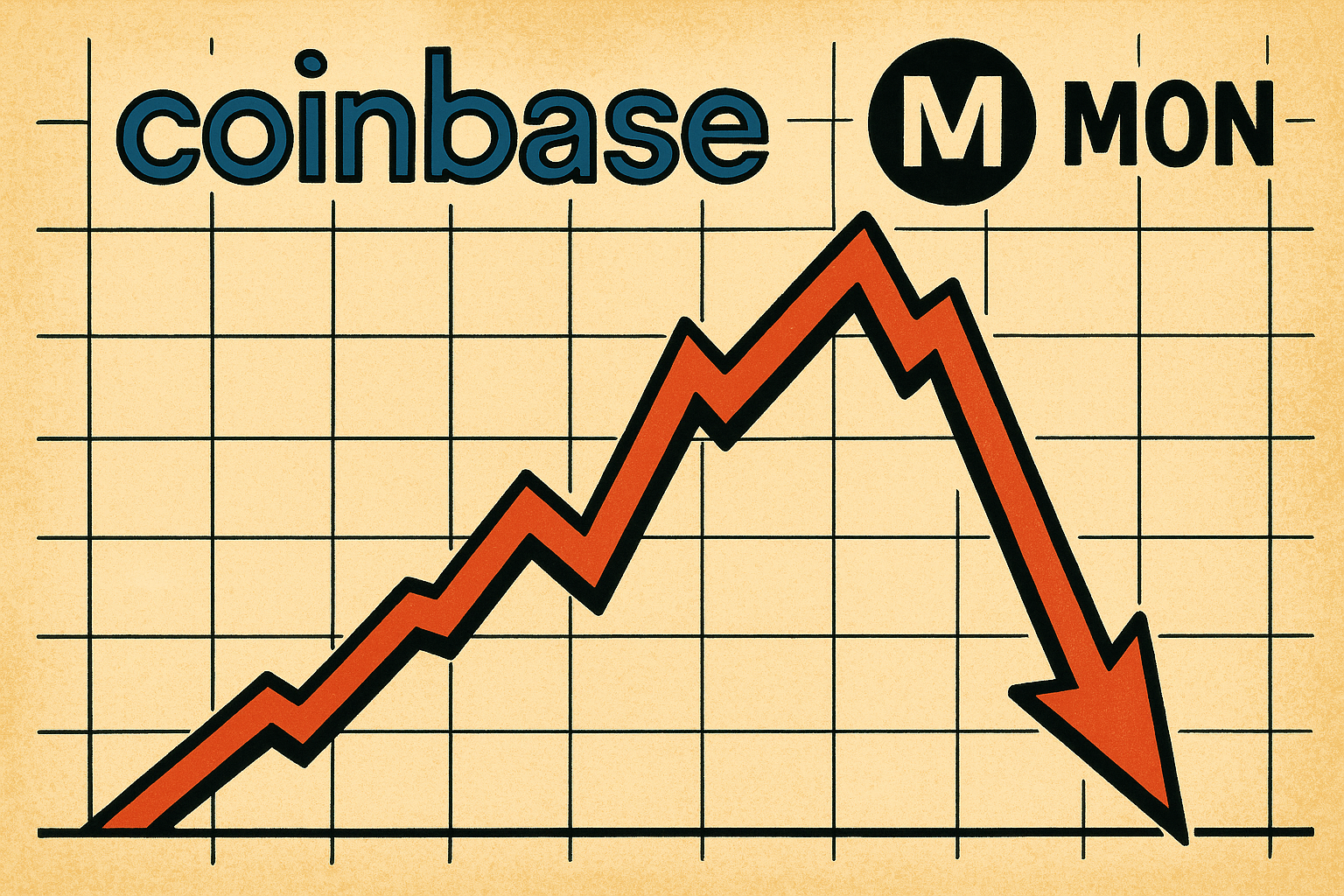News
Coinbase Unveils Token‑Sale Platform with Tough New “Anti‑Flipper” Rules

- Share
- Tweet /data/web/virtuals/383272/virtual/www/domains/theunhashed.com/wp-content/plugins/mvp-social-buttons/mvp-social-buttons.php on line 63
https://theunhashed.com/wp-content/uploads/2025/11/Coinbase-1000x600.png&description=Coinbase Unveils Token‑Sale Platform with Tough New “Anti‑Flipper” Rules', 'pinterestShare', 'width=750,height=350'); return false;" title="Pin This Post">
In a move that signals both innovation and caution in the crypto industry, Coinbase has launched a new token‑sale platform designed to give retail investors early access to tokens while putting strict guardrails in place to curb speculative flipping. The first offering on the platform will be the token from Monad, setting the stage for what Coinbase describes as a “new standard” for token launches.
Re‑introducing token sales for U.S. retail
Token sales had largely disappeared from U.S. retail investor participation after regulatory crackdowns post‑2018. Coinbase’s initiative marks a return to the spotlight for early‑stage token offerings in America. The company plans to host about one token sale per month through this new platform, opening a one‑week window for users to submit bids in USD Coin (USDC). The selected tokens are then allocated via an algorithm that aims to favour smaller orders and broader participation rather than rewarding speed and size alone.
Anti‑flipping rules and investor protections
Crucially, Coinbase has built in a set of rules aimed at deterring short‑term speculative behaviour. Users who sell their tokens within 30 days of listing may face reduced allocations in future offerings. Issuers and their affiliates will be prohibited from selling their holdings for six months after the public sale, and any secondary or OTC sales require Coinbase’s approval and must be publicly disclosed. These mechanisms are meant to promote token stability, align incentives with long‑term project supporters, and reduce the immediate dump risk often seen in earlier token‑offering models.
Why Coinbase is doing this now
There are several strategic drivers behind this launch. First, token‑sale activity has garnered renewed interest as projects seek more direct access to communities and retail investors. Second, Coinbase is looking to diversify its business beyond trading fees, expanding into new product categories and deepening engagement with its user base. Third, by layering investor protections and a more structured process, Coinbase is signalling an attempt to pre‑empt regulatory concerns that plagued the ICO era.
Implications for projects, investors and the ecosystem
For token‑issuing projects, this platform offers an opportunity to reach retail investors through a recognized exchange channel and to secure a listing thereafter. Coinbase confirmed tokens launched through the platform will later be listed on its exchange. This could reduce liquidity risk and simplify the path from fundraising to listing. For investors, the structured weekly window and algorithmic allocation replace the “first‑come, first‑served” rush of past offerings, potentially making participation fairer and less reliant on bot speed or large orders. From a broader ecosystem perspective, the approach could represent a maturation of how token‑sales are conducted, with more emphasis on alignment between users, projects and exchanges rather than a short‑term speculative mindset.
Challenges and caveats
Despite the promise, the model is not without potential pitfalls. The algorithmic allocation may limit upside for large orders, which might deter some institutional players used to bespoke allocations or private rounds. The prohibition on issuer selling and secondary OTC trades can help mitigate early selling pressure, but may also reduce flexibility for projects that need pre‑launch liquidity or partner exits. Moreover, although user allocations favour smaller orders, participants still need to be verified and compliant with Coinbase’s standards, which may limit involvement from less‑onboarded retail users. Finally, success will depend on execution: whether Coinbase maintains consistent monthly sales, the quality of projects accepted, and how well user‑allocation algorithms perform in practice without unintended bottlenecks or frustrations.
Why this matters for crypto investors
For investors active in the token‑offering space, this development suggests a shift in what matters when assessing an offering. Instead of simply chasing the biggest raise or fastest listing, attention may increasingly turn to the exchange channel, allocation algorithm, user protections, and the long‑term support expectations baked into the offering. Also, for retail investors, the reopened door via a major exchange like Coinbase means access to early‑stage tokens may become more democratized—provided they are willing to meet the eligibility and process requirements.
Looking ahead: what to watch
Key signals to monitor in the next few months will include the execution of the first token sale (Monad) and how smoothly the allocation and listing mechanics work for those participants. It will also be important to track whether Coinbase adheres to its one‑sale‑per‑month cadence and what kinds of token economics or project vetting standards it applies over time. Furthermore, how the market reacts around the listing and initial trading of tokens launched via this platform will provide insights into whether the “anti‑flipper” framework actually helps manage volatility or simply shifts the mechanics of participation. Lastly, regulatory responses may be worth watching: if a major exchange increasingly facilitates token‑sales with structured rules, regulators in the U.S. or abroad might use it as a model—or scrutinize it more closely.
Conclusion
Coinbase’s launch of its new token‑sale platform with anti‑flipping rules marks a meaningful evolution in how early crypto token offerings can be structured. By prioritizing fair allocation, investor protections and project‑incentive alignment, the company appears to be bridging the gap between the wild ICO style of 2017‑18 and a more institutionalized, community‑friendly model. For the crypto industry this could be a step toward more sustainable token launches and greater retail inclusion. For investors and projects, change is afoot—and participating in the new generation of token‑sales may require a different playbook than the one used in earlier cycles.
Ethereum
Small Kingdom, Big Move — Bhutan Stakes $970 K of ETH via Figment to Back National Blockchain Ambitions

Bhutan Turns Heads With Institutional‑Grade ETH Stake
The government of Bhutan quietly moved 320 ETH — worth roughly $970,000 — to Figment, the well-known staking provider, signaling a major shift in how the Himalayan kingdom engages with crypto. Rather than a speculative or retail‑style buy, this is an institutional‑level stake: the amount deployed corresponds to 10 full Ethereum validators (since each validator requires 32 ETH).
More Than Just Yield: Bhutan Anchors Crypto in Governance
Bhutan’s ETH stake comes on the heels of a far broader crypto‑adoption push. In October 2025 the country launched a sovereign national digital identity system — built not on a private chain, but on the public Ethereum blockchain. The decision to anchor citizen identities on a decentralized, globally supported network like Ethereum underscores a long‑term vision: decentralized identity, on‑chain transparency, and national infrastructure built with blockchain.
For Bhutan, this ETH stake isn’t about short‑term price swings or hype — it reflects a strategic bet on Proof‑of‑Stake infrastructure. By running validators via Figment, the government contributes to network security, potentially earns rewards, and aligns its own holdings and governance systems with the protocols underlying its digital‑ID rollout.
What This Signals for Ethereum — and for Crypto Governance
Though 320 ETH is a drop in the bucket compared to total staked ETH globally, the move carries symbolic weight. A sovereign state publicly committing funds to ETH staking via a recognized institutional provider adds to the broader narrative: that Proof‑of‑Stake networks are maturing, and that blockchain can underpin more than speculative assets — it can support identity, governance, and long-term infrastructure.
Moreover, it highlights that institutional staking services like Figment are increasingly trusted not only by hedge funds or corporations, but by governments. According to Figment’s own data, their Q3 2025 validator participation rate stood at 99.9%, and they reported zero slashing events — underlining the reliability such clients are counting on.
What to Watch Next
Will Bhutan stake more ETH? On‑chain data shows the wallet still holds a portion of ETH that remains unstaked — suggesting potential for future validator additions.
Will other nations follow suit? If Bhutan’s mixed use of crypto — combining reserve assets, public‑service infrastructure, and staking — proves viable, it could serve as a blueprint for other smaller states looking to modernize governance with blockchain.
Will this affect ETH’s valuation? Hard to say immediately. The 320 ETH is unlikely to move market prices by itself. But if this step becomes part of a larger trend toward institutional and sovereign staking, the cumulative effect on demand and network security could indirectly support ETH’s long-term value proposition.
Altcoins
Meme Coins Are Losing Their Mojo — From 20 % of Crypto Buzz to Just 2.5 % This Year

Meme‑Coin Hype Takes a Hard Hit
A recent report shows that collective interest in meme coins has plunged from about 20 % of all crypto chatter in late 2024 to roughly 2.5 % by October 2025 — a collapse of nearly 90 %. This shift reflects not only a drop in social buzz but also a broader retreat of speculative enthusiasm across the market. What once felt like the wild west of crypto — rapid launches, viral marketing and huge price swings — is cooling fast.
Market Metrics Confirm the Slide
The decline isn’t just anecdotal. Over the past year, more than 13 million meme tokens flooded the market, many with little to no utility — and most quickly vanished or failed. In a sector built on hype, many of these coins turned out to be short‑lived bets. Overall, the fully diluted market capitalization of memes has dropped by nearly 50 % year‑to‑date, according to blockchain analytics firms.
Trading volume has also cratered. In the first quarter of 2025, memecoin trading volume reportedly fell by 63 %. In many markets, memecoins’ share of overall trading volume dropped below 4 %, marking a dramatic retreat from their previous prominence.
What’s Driving the Decline
The collapse appears driven by a mix of oversaturation, weak fundamentals, and shifting investor preference. The meme‑coin ecosystem became overcrowded — tens of millions of projects launched, many with no clear roadmap or utility beyond chasing quick returns. That oversupply, combined with a broader crypto market slump, has wreaked havoc on liquidity and investor confidence.
Some analysts also cite growing regulatory scrutiny and a rising demand for real utility and transparency rather than hype‑driven “get‑rich‑quick” schemes. Meanwhile, capital and attention are rotating toward more tangible crypto sectors — such as AI‑powered tokens, infrastructure projects, DeFi, privacy coins and even traditional‑finance–style crypto instruments.
Could This Be a “Generational Bottom”?
Some within the community argue that the crash may bottom out soon — and that a new cycle could follow. Once the “dead weight” of unsustainable projects is cleared out, more serious, utility‑driven tokens could regain attention. Others believe the meme‑coin era may be effectively over — that the speculative mania has dissipated, and unless a meme coin brings real innovation or value, investors will avoid it.
Broader Implications for Crypto Markets
The downfall of meme coins underscores a broader maturation of the crypto industry in 2025. Markets appear to be shedding excess speculation and gravitating toward assets with fundamentals. This could lead to healthier ecosystem growth, better token design, and more sustainable long‑term investment — but also less room for high‑risk, high‑reward “moonshot” plays that defined crypto’s early years.
Altcoins
NYSE Arca Files to Launch Altcoin-Focused ETF

Fresh Rule‑Change Proposal Seeks Green Light From SEC
A fresh proposal filed by NYSE Arca could soon bring a new kind of cryptocurrency investment product to the U.S. market. In partnership with asset management giant T. Rowe Price, the exchange is seeking regulatory approval to list an actively managed crypto ETF that goes beyond Bitcoin and Ethereum. If approved, the fund would give investors exposure to a mix of top altcoins—like Solana, XRP, Cardano, and more—through a traditional stock exchange, eliminating the need for wallets, private keys, or crypto trading accounts.
What the Fund Would Do: A Broad, Actively‑Managed Crypto Basket
The Fund isn’t a passive single‑asset product but aims for active management. Its objective is to outperform the FTSE Crypto US Listed Index over the long term.
At launch the Fund intends to hold a diversified basket of “Eligible Assets,” which currently include major tokens such as Bitcoin (BTC), Ether (ETH), Solana (SOL), XRP, Cardano (ADA), Avalanche (AVAX), Litecoin (LTC), Polkadot (DOT), Dogecoin (DOGE), Hedera (HBAR), Bitcoin Cash (BCH), Chainlink (LINK), Stellar (XLM), and Shiba Inu (SHIB).
The Fund may hold as few as five, or as many as fifteen, crypto assets at any given time — and is not strictly tied to the index’s weighting. It may over‑ or underweight certain assets, or include crypto outside the index, guided by active selection criteria such as valuations, momentum and fundamental factors.
The idea is to give investors exposure to a diversified crypto portfolio without having to manage wallets, custody, and rebalancing — while potentially delivering better returns than a static, index‑tracking fund.
Risk Controls, Custody and Governance
To ensure safety and regulatory compliance, the Fund will store its crypto holdings with a dedicated crypto custodian. Private keys will be secured under strict controls, preventing unauthorized access or misuse.
When the Fund stakes any crypto (if staking is employed), it will maintain policies to ensure sufficient liquidity to meet redemptions, especially if a large portion of assets becomes illiquid or locked.
Valuation of the crypto holdings — used to compute Net Asset Value (NAV) per share — will rely on reference rates from third‑party price providers, aggregated across multiple platforms. The NAV will be computed daily, aligned with close of trading on the Exchange or 4:00 p.m. E.T.
Why It Matters for Crypto and Traditional Finance
This filing reflects a broader shift in traditional financial markets embracing diversified, regulated crypto investment vehicles. Unlike earlier spot‑crypto ETFs designed for single assets (e.g., Bitcoin), this Fund proposes a multi‑asset, actively managed basket — potentially appealing to institutional investors and diversified‑portfolio allocators seeking crypto exposure with traditional ETF convenience.
If approved, the Fund would offer a streamlined, compliance‑friendly bridge between traditional capital markets and crypto assets, lowering operational friction for investors who prefer not to deal with wallets, exchanges, or self‑custody.
The approach may also set a precedent: showing that active crypto ETFs can meet listing standards under rules originally written for commodity‑based trusts. This could open the door for more innovation — perhaps funds targeting niche themes (smart‑contract tokens, layer‑2s, tokenized real‑assets) while still abiding by exchange and regulatory requirements.
What’s Next
The SEC review period typically spans up to 45 days from publication (or longer if extended), during which comments from market participants and the public may shape the final decision.
If approved, it may take some additional time before shares begin trading — during which documents like the fund’s prospectus, ETF symbol, and listing date will be finalized and disclosed by the sponsor.
-

 Cardano2 months ago
Cardano2 months agoCardano Breaks Ground in India: Trivolve Tech Launches Blockchain Forensic System on Mainnet
-

 Cardano2 months ago
Cardano2 months agoCardano Reboots: What the Foundation’s New Roadmap Means for the Blockchain Race
-

 Cardano2 days ago
Cardano2 days agoSolana co‑founder publicly backs Cardano — signaling rare cross‑chain respect after 2025 chain‑split recovery
-

 Bitcoin2 months ago
Bitcoin2 months agoQuantum Timebomb: Is Bitcoin’s Foundation About to Crack?
-

 Cardano2 months ago
Cardano2 months agoAfter the Smoke Clears: Cardano, Vouchers, and the Vindication of Charles Hoskinson
-

 Cardano2 months ago
Cardano2 months agoMidnight and Google Cloud Join Forces to Power Privacy‑First Blockchain Infrastructure
-

 Ripple2 months ago
Ripple2 months agoRipple CTO David “JoelKatz” Schwartz to Step Down by Year’s End, but Will Remain on Board
-

 News2 months ago
News2 months agoRipple’s DeFi Awakening: How mXRP Is Redefining the Role of XRP











